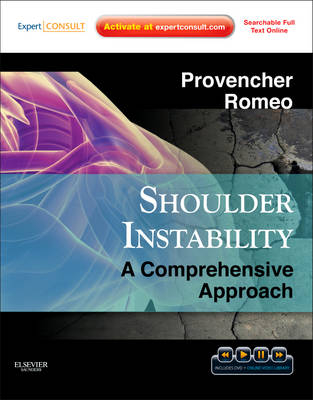
Shoulder Instability: A Comprehensive Approach
W B Saunders Co Ltd (Verlag)
978-1-4377-0922-3 (ISBN)
Shoulder Instability, by Drs. Mark Provencher and Anthony Romeo, is the first comprehensive resource that helps you apply emerging research to effectively manage this condition using today's best surgical and non-surgical approaches. Detailed illustrations and surgical and rehabilitation videos clearly demonstrate key techniques like bone loss treatment, non-operative rehabilitation methods, multidirectional instability, and more. You'll also have access to the full contents online at www.expertconsult.com.
Watch surgical and rehabilitation videos online and access the fully searchable text at www.expertconsult.com.
Stay current on hot topics including instability with bone loss treatment, non-operative rehabilitation methods, multidirectional instability, and more.
Gain a clear visual understanding of the treatment of shoulder instability from more than 850 images and illustrations.
Find information quickly and easily with a consistent format that features pearls and pitfalls, bulleted key points, and color-coded side tabs.
Explore shoulder instability further with annotated suggested readings that include level of evidence.
Dr. Provencher was recently named one of the Top 28 Shoulder Surgeons in the United States and also one of the Top 28 Knee Surgeons in the United States by Orthopaedics Today. He is also recognized by Becker's Orthopaedics as "One of 59 Great Orthopaedic Surgeons. His research includes over 264 peer-reviewed publications and articles, 148 chapters, and author of six textbooks. He has given over 500 peer-reviewed and invited national and international presentations in the realm of sports medicine and leadership. Anthony A. Romeo, MD.. As a surgeon and researcher, he works at the intersection of science and sports to restore function using minimally invasive, cutting-edge techniques. His patients include individuals needing to get back to work, professional athletes seeking a return to a similar level of pre-injury performance, and those who are looking for an improved quality of life. Dr. Romeo spent 25 years practicing in Chicago, IL where he served as a team physician to The Chicago White Sox and The Chicago Bulls, as well as a consultant for numerous NFL, NCAA, and Olympic level athletes for more than 15 years. As a longtime member of the Chicago community, he has been recognized as one of the Best Doctors in America many years in a row and is one of fewer than 6% of physicians selected to receive the Patient's Choice Award on a consistent basis, as well as being recognized a Top Doctor for more than 10 years. In 2018, Dr. Romeo had the opportunity to move to New York City to serve as the Chief of Orthopaedics for the Rothman Orthopaedic Institute in New York. His work included being on Staff at Lenox Hill Hospital, as well as a full professorship in the Department of Orthopaedics at the Zucker School of Medicine at Hofstra/Northwell Health. He was immediately recognized by Castle Connolly as a Top Doctor for the New York Metro Area.
Introduction Shoulder Instability
SECTION 1: ANATOMY AND PRINCIPLES OF TREATMENT
Ch 01 Clinical Anatomy and Biomechanics of the Glenohumeral Joint (Including Stabilizers)
Ch02 Examination and Classification of Instability
Ch03 Beach and Lateral Setup - Pros and Cons
Ch04 Open and Arthroscopic Instrumentation for Instability Repair
Ch05 Sutures and Glenoid Anchors for Instability
SECTION 2: ANTERIOR INSTABILITY
Ch06 Findings and Pathology Associated with Anterior Shoulder Instability
Ch07 Clinical History and Physical Examination
Ch08 Radiographic Studies and Findings
Ch09 Non-Operative Treatment of Anterior Shoulder Instability
Ch10 Non-Operative Rehabilitation for Traumatic and Atraumatic Glenohumeral Instability
Ch11 Arthroscopic Treatment of Anterior Instability - Surgical Technique
Ch12 Open Treatment of Anterior Instability - Surgical Technique
Ch13 Biomechanics of Glenohumeral Bone Loss and Treatment Mechanics
Ch14 Radiographic and Arthroscopic Evaluation of Glenoid and Humeral Head Bone Loss
Ch15 Arthroscopic Treatment of Glenoid Bone Loss - Surgical Technique
Ch16 Open Bony Augmentation of Glenoid Bone Loss - The Latarjet and Variants - Surgical Technique
Ch17 The Latarjet Procedure - Technique and Fixation Constructs
Ch18 Technique of Arthroscopic Bristow-Bankart Procedure
Ch19 Open Bony Augmentation of Glenoid Bone Loss - Illiac Crest and Allograft - Surgical Technique
Ch20 Humeral Head Defects - Biomechanics, Measurements and Treatments
Ch21 Recent Advances in the Diagnosis and Treatment of Glenohumeral Bone Loss
Ch22 Rehabilitation: Return-to-Play and In-Season Guidelines
SECTION 3: POSTERIOR INSTABILITY
Ch23 Pathology and Biomechanics of Posterior Instability
Ch24 Clinical History, Examination and Surgical Decision Making
Ch25 Imaging Findings in Posterior Instability
Ch26 Arthroscopic Treatment of Posterior Instability
Ch27 Open Surgical Treatment and Posterior Glenoid Bone Loss
Ch28 Rehabilitation after Posterior Instability Repair - Open vs. Arthroscopic
SECTION 4: MULTIDIRECTIONAL INSTABILITY
Ch29 Pathology and Findings in Patients with Multidirectional Instability
Ch30 Clinical History, Examination, Arthroscopic Findings and Treatment of Multidirectional Instability
Ch31 Non-Operative Management and Scapular Dyskinesis
Ch32 Arthroscopic Treatment of Multidirectional Instability - Surgical Technique
Ch33 Open Treatment of Multidirectional Instability - Surgical Technique
SECTION 5: REVISION INSTABILITY AND SPECIAL TOPICS
Ch34 Instability Treatment Failure - Common Reasons and Prevention
Ch35 Rotator Interval - Considerations and Techniques for Instability
Ch36 Extensive Labral Tears - Pathology and Surgical Treatment
Ch37 Nerve Injuries with Instability Procedures - Prevention and Management
Ch38 Subscapularis Deficiency after Instability Procedures - Prevention and Management
Ch39 Capsular Deficiency with Recurrent Instability
Ch40 Glenohumeral Stiffness and Arthritis after Instability Surgery - Causes and Surgical Treatment
Ch41 Recognition and Management of Combined Instability and rotator Cuff Tears - Surgical Management
Ch42 The Patient with Hyperlaxity and Shoulder Instability - Ehlers Danlos and Other Disorders
Ch 43 Management of Chronic Shoulder Dislocations
| Verlagsort | London |
|---|---|
| Sprache | englisch |
| Maße | 216 x 276 mm |
| Gewicht | 1610 g |
| Themenwelt | Medizinische Fachgebiete ► Chirurgie ► Unfallchirurgie / Orthopädie |
| ISBN-10 | 1-4377-0922-2 / 1437709222 |
| ISBN-13 | 978-1-4377-0922-3 / 9781437709223 |
| Zustand | Neuware |
| Haben Sie eine Frage zum Produkt? |
aus dem Bereich


